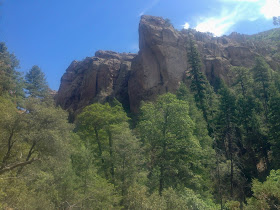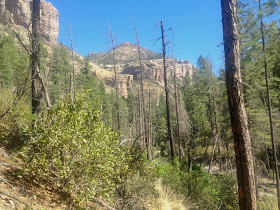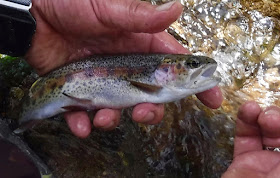 |
| Rain Creek Mesa |
My wife and I visited Rain Creek quite a few years ago. We were staying at the Bear Mountain Lodge in Silver City and ventured out for a day hike. I also had the idea of doing a little fishing. Well, we hiked down to the creek from Rain Mesa. The stream had some water at the crossing, but I didn't see any fish. We continued on FT 189 up the east side of the canyon where it treacherously and precipitously winds up to the top of the ridge between Rain Creek and West Fork Mogollon Creek. Where it leveled off somewhere up high, but before we could look down into the West Fork, we decided to call it day. Back down at the creek, I tried a little fishing. There were no fish. I hiked a ways up stream, and instead of finding fish, the water went underground. The creek looked just like a cobblestone road. Now I know, if I had continued on for a while longer I would have found both.
I returned to Rain Creek on Tuesday, this time with friend Doug Scott. Doug, as almost always, was stalking a waterfall, this one, which looks like a spectacular 200 footer on Google Earth, is way up high on the eastern fork of Rain Creek, six and a half miles from the trailhead. We had spent the night at Los Olmos in Glenwood and drove off around 6:30.We started our hike, after a little mix-up with the roads getting to the trailhead, at around 7:50. It was already feeling warm. Down in the canyon it was only bit cooler. Where the official trail switchbacks to south on the east side of the creek there is a sign, that's where we took off onto the abandoned, but still usable Rain Creek Divide Trail which heads north. We followed the trail, then at the first creek crossing, we began using the creek itself for a stretch. It was dry where we hit it, and for a ways upstream, but soon we found water, and with it, fish. Dark forms in the dozens were wriggling about in every pool, which were anywhere from 6 inches to 3 feet deep, and they scarcely acknowledged us as we passed by. The creek sides were green with alder, willow and boxelder and for the second time in less than week I was just enjoying being in place that wasn't dry and hot.
 |
| Rain Creek |
 |
| Several trout visible in this photo |
At times we used the trail, which climbed ridiculously high above the creek. And when we couldn't find it on the other side we'd try the creek bed again for awhile, sloshing through the waters filled with hundreds of unwary trout, and then crawling, climbing, going over, under and through boulders and flood lain debris.


Through one stretch, the boulders went from big to bigger to biggest with king of them being close to 100 feet high and at least 100 feet wide. It must have been quite a thing the day that one broke loose and came tumbling down the mountain.

Up on the west side were enormous hoodoos, towers and cliffs of pink conglomerate. A natural arch was up there too. Soon, the orange cliffs, full of alcoves and caves only for eagles, rose up 1,000 feet on both sides of the canyon.



We were high up on the west side on the trail which had become just a narrow dirt tread more suitable for deer than the tired old legs of two adventurers past the half-century mark and had passed the steep slashes in 10,658 foot Sacaton Mountain that are the west and middle forks when we decided to head down and continue up the east fork, which is the most sizable and more like a continuation of the main creek. Now we were just climbing from pool to pool, each one had me thinking it surely must be the last one to hold trout and then being proven wrong each time. Throughout the day the average size of the fish in the pools seemed to increase the farther up we went, although some who had chosen the wrong pool to hold out the drought in were surely stranded. I have heard, though not had confirmed, that next door in the West Fork Mogollon, way up high in the inaccessible gorge carved in bedrock are two foot fish. The best I saw in Rain Creek in this low water year was probably close to 12 inches, but the whole environment seems fertile enough to grow larger fish during wet times. We finally reached a wall of rock trickling cold precious flow on its face that would have been a beautiful 25 foot white waterfall had we had something even vaguely resembling average precipitation this year.
I was done climbing. I pulled out my oldest and cheapest rod ( a 7 foot switchable fly/spinner bought at Academy in Houston more than 20 years ago) and my Shakespeare 1094 reel. Doug went up high on first one side, before switching to the other in search of his waterfall. I wished him well and then calmly untangled my line. Then, because we had been happily observing the trout taking flies on the surface all day, I attached the smallest dry fly ( a blue dun looking thing) and was in business. All I'll say about the fishing in these upper reaches is that it was hilariously easy. You can catch as many as you want. The only problem is getting the bigger fish to come to your fly before one of the many four or five inchers greedily grabs it. One method that seemed to work was to run or skim the fly away from them which may trigger a greed reflex ( Rex Johnson Jr. observed this as well in his seminal book Fly Fishing in Southern New Mexico ). It was fun. They definitely look like a mix as far as phenotype, even high up on the forks, similar to wild fish I've caught in other parts of the Gila. Doug remarked that I had caught fish in all three of the upper forks. I continued to fish as we scrambled back down. The fish were more wary lower down, but still willing at least to approach the fly even while I stood in plain view at times.
I would have liked to fish more, but now we were working on getting back before dark. We rested at a pool below a waterfall on the west fork, where I caught my largest fish (10-11 inches). I had forgotten my lunch and had only trail mix, no worries though, I was running on wilderness power at this point.

We stayed in the stream for awhile. Doug was wanting to avoid the lush poison ivy that grew along the trail, and I wanted to avoid all the climbing, but eventually we got back on it to put the miles away. A healthy looking black bear crossed in front of us and went up the hill. We crossed the stream over and over, each time we were on the east side speculating if we were on final stretch to FT 189 and then the last leg of our exit. We stopped at the last creek crossing. I drank what I think was my seventh or eighth liter of water of the day. My feet were completely marinated and tenderized. I had soaked my shirt earlier to stay cool, but really the 600 foot, less than 2 mile climb out, now on the good, maintained trail was not hot (it was now past seven ) and really a piece of cake as we took a steady, but relaxed paced and got back to the vehicles in reasonably good shape.

Doug did not find his waterfall, the terrain perhaps too treacherous up above, and the stamina in too short supply, but it didn't dampen his enthusiasm for the place or the trip. Our 12 hour day in the Gila Wilderness was done. As I drove home in the darkness, my brain kept filling in pines, firs and cliffs on the sides of the highway instead of desert flatlands I knew were there.















Hi Devon, I've been reading and enjoying your blog for several months. This one really knocked me out. Thanks for taking us along on another gorgeous hike I've never heard of anywhere else. You're an inspiration to explore southern NM.
ReplyDeleteThanks so much. Hope you can get out there and enjoy! Devon
ReplyDelete